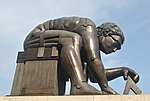Statue of William Shakespeare (Roubiliac)

In 1757, the actor David Garrick commissioned the sculptor Louis-François Roubiliac to make a full-size marble statue of William Shakespeare for Garrick's octagonal Temple to Shakespeare, erected near his villa beside the River Thames at Hampton, to the west of London. The sculpture cost 300 guineas and was installed at Garrick's temple in 1758; it remained there until it was bequeathed to the British Museum along with Garrick's books in 1779. The sculpture was transferred to the new British Library in 2005, where it is displayed on a new travertine plinth beside the main staircase in the main entrance hall. The sculpture depicts Shakespeare standing, leaning with his right arm on a lectern covered with a fringed cloth. His right foot is forward and body leaning to the right, with his hips thrust out awkwardly to the left. His right hand is holding a quill pen while the left hand is raised to his chin with the index finger extended along the jawline, as if in thought. The subject is balding but bearded, with ringlets of hair at his temples. Rather than Tudor costume, he is wearing anachronous 17th century "Van Dyke" dress, including a shirt with an elaborate lace collar and cuffs; a long jacket with many buttons, but unbuttoned over the lower body; short trousers with fringed legs; stockings and heeled shoes; all draped in a billowing cloak. The art historian Margaret Whinney describes Roubiliac's bust as having "Van-Dyckian elegance" and notes that "he has greatly ennobled the head".
Excerpt from the Wikipedia article Statue of William Shakespeare (Roubiliac) (License: CC BY-SA 3.0, Authors, Images).Statue of William Shakespeare (Roubiliac)
Euston Road, London Somers Town (London Borough of Camden)
Geographical coordinates (GPS) Address Phone number Website Nearby Places Show on map
Geographical coordinates (GPS)
| Latitude | Longitude |
|---|---|
| N 51.5297 ° | E -0.1275 ° |
Address
British Library (New British Library)
Euston Road 96
NW1 2DB London, Somers Town (London Borough of Camden)
England, United Kingdom
Open on Google Maps







